Chuck Ranum runs Triple-R Recycling in North Dakota, and makes biodiesel from waste cooking oil for himself and for the members of a small local cooperative. They use it in their vehicles, for home-heating, for farm-tractors, and they can't get enough. Chuck will produce about 2,000 gallons this year, and is planning to increase production by four times, to 160 gallons a week.
Email: "Chuck Ranum" <tripler@gondtc.com>
|
|
|
|
|
|
|
|
|
|
|
|
|
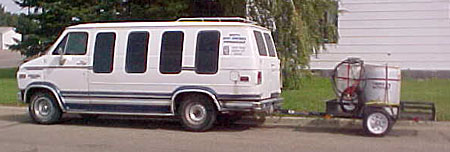 |
|
"I went 3000 miles on my own fuel in one trip with this setup" -- Chuck Ranum |
|
|
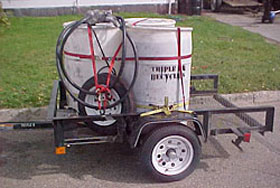 |
 |
Message from Chuck Ranum, 4 Nov 2004:
1st processor in Mexico -- I have just returned (at 4am) from Oaxaca, Mexico. I and a friend flew down on Oct. 22 and built a completely portable, single-pump, 165 liter processor. Our hosts think it is the first one in Mexico. We spent 6-7 days building (all local materials) and teaching. The University contacted me through Journey to Forever, and asked me to come down and help them out. Mike and I did it for the adventure, and to spread the gospel of Biodiesel to a country that NEEDS it.
 Details and photographs at the Universidad Vasconcelos-Univas website:
Details and photographs at the Universidad Vasconcelos-Univas website:
Proyecto Biodiesel - Univas (Universidad Vasconcelos)
http://www.univas.edu.mx/biodiesel.html
English translation: Project Biodiesel - Univas
http://snipurl.com/loms
Procesador de Biodiesel UNIVAS-RANUM (Planos y fotos, lista de materiales, procedimiento)
http://www.univas.edu.mx/procesador.html
English translation: Processor of Biodiesel Univas-Ranum (Plans and photos, bill of material, procedure)
http://snipurl.com/lomt
Imágenes del Procesador -- Images of the Processor
http://www.univas.edu.mx/univasranum.html
Planos del Procesador -- Plans of the Processor
Diagrama -- Diagram
http://www.univas.edu.mx/Dibujo%20Planta%20Crespo%20for%20JPEG.jpg
Croquis -- Sketch
http://www.univas.edu.mx/Plan%20de%20tanques%20CrespoJPEG.jpg
Chuck Ranum:
My 1983 Chevrolet van has a 6.2 liter V-8 with 117,000 miles on it. I burn 100% biodiesel during the warm months of the year, and a mix of biodiesel and petro-diesel in the winter.
I've heated my home in North Dakota for over a year now on 100% biodiesel, and supplement with electricity. As North Dakota winters can get into -30 to -40 below zero F, we use 600+ gallons every winter. It's just a standard forced-air furnace, the ordinary 20-year-old pressure pump injection, spark ignition type that has been around forever. Homebrew biodiesel needs to be washed, or the excess methanol will eat the seals in furnace pumps in short order.

Collection trailer
|
My main biodiesel feedstock is WVO. I collect it from one hospital, one bakery, three convenience stores, and five restaurants.
I picked up almost a dozen open-top 55-gallon barrels from an engine rebuilder. He had chemical shipped to him in them, and they were headed to the junkyard. He gave them to me, and all of them came with rubber-edge lids. They don't need cutting and the top edge is rolled over for safety. One became my reactor tank, one became my preheat tank, all but one of the rest were fitted with hinges and latches left at different WVO producers.
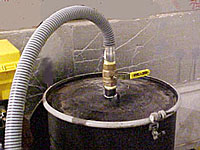
Lid with valve

Collection barrel
|
Everyone was perfectly happy to get them, as grease pickup was costing them $40 a time. I haul the grease for free, and my barrels take up much less space than the old dumpsters.
One of the barrels is bolted onto my trailer. My '78 Jeep has an on-board air compressor. A standard York reciprocating A/C compressor can be used as both an on-board air and suction pump. They will generate over 120 psi, at a fast enough flow rate to run most air tools (engine at idle to 1200 rpm max.) and enough suction to flatten a 55-gallon steel drum like an empty beer can faster than you would believe!
I have one of the barrel lids fitted with a 1-1/2 inch ball valve, PVC dip tube, and 10-foot heavy-duty hose. I clamp the lid onto the WVO collection barrel, put the end of the hose into the barrel on the trailer, and pressurize the collection barrel with my compressor. The grease is forced up the tube, through the hose into the trailer barrel with no bucket-spilling or back straining at all. I can pump 'gloppy' grease, about the consistency of mayonaise, or even thicker. I take 50 gallons out in less than 5 minutes.
When I get home, I put the same lid on my trailer barrel and push the grease into my preheat barrel, through a mesh screen that takes out the french fries and broken spatulas.
In the winter I cheat, and drop off empty barrels. I haul the frozen-solid ones home and put them in my heated garage until they will pump.
I'm going to get a 250 gallon trailer soon, so I can start collecting from restaurants in the nearby cities as well.
The processing setup

This is my biodiesel processing setup. The barrel on the left (back) is the reaction tank, in the middle is the preheat tank. On the far right is the wash tank (black). The black 55-gallon drum to the left (foreground) is the methanol barrel. The sodium methoxide mixing tank is on the floor, middle. Between the two is the 5-gallon glycerine jug.
|
My processor has a capacity of 42 gallons a day (160 liters). I will do 30 to 50 42-gallon batches this year. I run a titration and a test batch before every single one. We use a 1 hour mix time and 20 hour settling time.
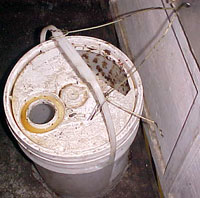
Prefilter top
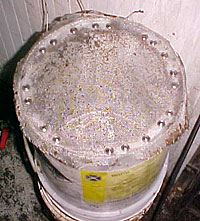
Prefilter bottom, with screen
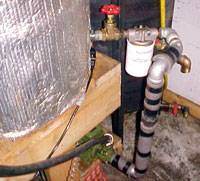
40 micron filter assembly from the preheat tank

The dual valve drain under the reaction tank
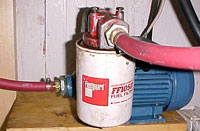
The fuel pump and 10-micron final filter
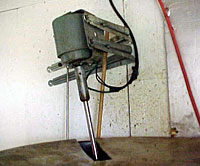
The reaction tank mixing motor
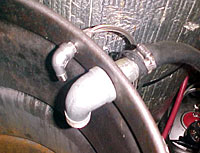
Pre-filtered oil from the preheat tank and catalyst from the sodium methoxide tank are pumped to the injectors, two pipe elbows mounted to the reaction tank. The smaller one is the stainless steel sodium methoxide injector, the larger is a 1-inch fitting where the hot filtered WVO enters.
|
The WVO comes from the trailer outside via the large grey 1-1/2 inch grease hose which leads into a bucket hanging over the preheat tank. This is the screen prefilter, made from a closed-top 5 gallon pail with a cut-out bottom replaced by steel mesh to get the big chunks. The lid is cut part-way, to allow scraping of the screen with a long wooden spatula while it is doing its job. The grease hose is inserted through the round opening, which holds it rather nicely. I can filter 50 to 100 gallons before cleaning, which is no more than tapping on it upside down and shaking the chunks out through the larger opening in the top.
The 55-gallon preheat tank (middle) has the lid propped open here. Both the preheat tank and the reaction tank (left) are insulated with Reflectex brand insulation (basically bubble-wrap sandwiched in between aluminum foil). Both tanks have a 1500-watt heating element installed on the back side, wired to an ordinary water heater thermostat attached in the middle of the barrel. The thermostats are simply held in place by a few wraps of black electrical tape that goes all the way around the barrel. It might not sound secure, but it works very well.
Four inches up from the bottom on both tanks I cut a hole and welded a short piece of pipe fitting, sized to fit the electric water heater elements. This required enlargement with a pipe-tap to allow the element to seat completely, preventing leaks. Correct wiring diagrams come with new thermostats.
I have to drain and scrape the bottom of the preheat tank every 400 gallons or so to keep the buildup from reaching the heating element. The element itself has a round piece of screen surrounding it to limit food particle buildup.
The oil leaves the preheat tank via a valve 4 inches above the bottom to miss the settled chunks and water, and to a 40 micron filter assembly and down to a pump that sends it to the reaction tank through a large black hose. This is just a cheap clear water pump out of a catalog, and seem to work just fine in this application.
The reaction tank is also a standard 55-gallon open-top drum. I stood the barrel upright on soft ground, put a six-foot long 1"-diameter pipe in the middle of the bottom, and put the full weight of a tractor loader bucket on the top end of the pipe. This bowed the center of the bottom about 1". I drilled a small pilot hole dead center and used a step drill to enlarge the hole to 1 inch. A standard 1-inch tank fitting is welded to the bottom. A short nipple threads into this. A ball valve shutoff is connected directly to a dual valve. One hose is the glycerine drain, the other goes to the pump, which sends the biodiesel through a 10 micron diesel fuel filter, and on to the wash tank. This is also a cheap clear water pump.
I use a chemical resistant hose between the reaction tank and the pump, and between the pump and the wash tank. The methanol content in the fuel destroys ordinary Goodyear fuel line in a few months. I use ordinary fuel hose for the glycerine drain, it gets gummy pretty fast, but holds up well enough for that purpose.
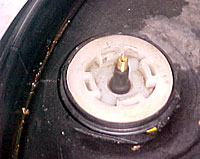
Tire-valve in the methanol barrel
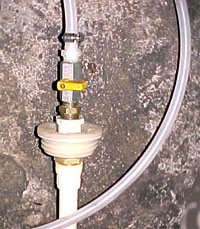
Above and below: methanol barrel
dip tube/valve assembly
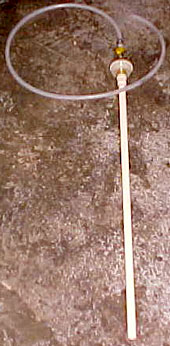
|
The reaction tank mixing motor was salvaged from a hospital boiler room renovation. It is a sealed-type unit, safe for mixing volatile chemicals. It's 1/3 hp, mounted on the wall above the reaction tank, with a commercial stainless steel shaft and 3-blade 4-inch diameter mixing propeller, 1/3 up from the bottom, off to one side 3 inches, and set at about a 10 degree angle. It was all surplus, so I got it for free.
The prop spins at a high enough speed to "howl", even 28 inches below the surface in 42 gallons of oil. The sodium methoxide is injected slowly over a 10-minute period directly into this vortex. This seems to be a violent enough mixing action, as I've had almost no failures in over 2000 gallons of product so far. I use a factory-made slip-on plastic lid, and cover the slot for the shaft with a plastic bag. Very little vapor escapes.
I buy seven 55-gallon drums of methanol at a time for $100 per drum, plus a $20 deposit per drum. I store them outside city limits.
I made a dip tube/valve assembly that fits one bung on the methanol barrel, and put a tire valve in the other bung for an air-hose. Methanol is pumped from the methanol barrel to the sodium methoxide mixing tank.
The 10-gallon sodium methoxide mixing tank was a stainless steel cannister from an old coke machine, also salvaged. The mix motor is also salvaged. The air pressure supply tube is coiled hospital oxygen tubing, salvaged. It allows me to move the methoxide tank around without having any hoses on the ground to get stepped on.
The tank comes with a stainless steel dip tube that reaches almost the very bottom. This is hooked to a teflon and stainless steel 1/4" line that feeds into a stainless steel fitting at the top edge of the reaction tank, right next to the 1-inch hot-grease inlet. I tapped the dip-tube fitting to accept the threaded end of the feed line. The other fitting was a seal on the gas inlet (these vessels operate with CO2 pressure). I modified it to accept the stainless steel propeller shaft.
I pump 8.4 gallons of methanol into the mixing tank and then pour the pre-measured NaOH into the methanol while it is agitating, over about 5 minutes. This is the only time the possibility of contact with sodium methoxide exists, and I wear safety equipment. I seal the vessel with the original cap and continue to mix for 5 minutes. Then I pressurize the tank with a tiny air pump (7 psi). This forces the sodium methoxide up the dip tube, through the teflon/stainless line and injects it into the stirring hot WVO in the reaction tank without my being exposed to it.
|
|
|
|
|
|
|
|
|
|
|
|
|
|
|
|
|
|
|
|
The sodium methoxide mixing tank
|
|
|
|
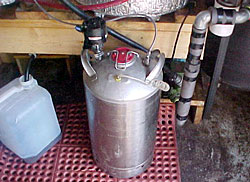 |
|
|
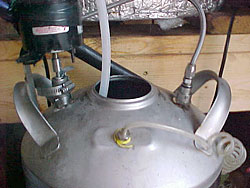 |
|
The sodium methoxide mixing tank -- a 10-gallon stainless steel cannister salvaged from an old coke machine.
|
|
|
|
The methanol supply tube going in, the mix motor (left), dip tube (right), and the air pressure supply tube (front).
|
|
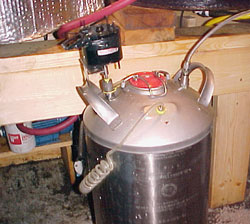 |
|
|
|
|
|
|
|
|
|
|
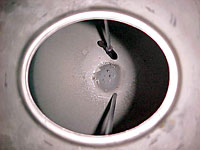 |
|
|
|
|
|
The interior of the mixing tank, showing the dip tube and homemade propeller.
|
|
|
The tank with the pressure lid in place.
|
|
|
|
|
|
|
The plastic glycerine jug is a 5-gallon jug that the restaurants get their grease in. I have one of them save them for me. They are nice and clean, and the glycerine drains into them and sets up nicely. Later, they can be cut open very easily, to allow the solid glycerine block to be dropped into a melting tank to be fed to our new, preheater equipped, used oil furnace to heat our building next winter.

This is my control panel. Wiring it was simple enough. Surplus box, toggles, indicator lights and new wire nuts, cord ends and a 75-foot heavy duty extension cord. I don't have to switch cords around all the time now.
|
The wash tank is made from an 80-gallon water-heater. I cut the bottom off, turned it upside down and welded legs on. It had fittings in all the right places, and has a beautiful bowl bottom. It would, in fact, make a great biodiesel reaction tank! The steel is far thicker than a barrel, and there are fittings for heating elements already in, as well as a fitting on the bottom (was the top) that valves could screw right into. I use a large aeration stone I bought from an aquaculture supply house (attached to the yellow hose). I intend to get rid of the hose and attach the stone through a fitting on the bottom of the tank. In order to do this, you must use a check valve, or water and fuel will backfeed to your compressor as soon as you shut it off!
During the summer the washed biodiesel goes into black barrels in the sun to get rid of the last of the water.
I just made a deal to put 5 Lennox solar water heater panels on the roof (surplus again, circa 1978). Using a small circulating pump and a coil of tubing in our WVO preheater, we should eliminate about 50% of our "wasted" electricity use on the preheat side. If this is sucessful, we may do the same for our reactor vessel. This would almost bring us to the point that we could supply our remaining electricity needs with a few solar panels.
Biodiesel processors
Introduction
Scaling up
Hazards
Test-batch mini-processor
Simple 5-gallon processor
Journey to Forever 90-litre processor
The 'Deepthort 100B' Batch Reactor
Ian's vacuum biodiesel processor
Chuck Ranum's biodiesel processor
"Foolproof" method processors
The touchless processor
Joe Street's processor
Continuous reactors
How to make a cone-bottomed processor
Biodiesel technology
Biofuels at Journey to Forever
Biofuels
En español -- Biocombustibles, biodiesel
Biofuels Library
Biofuels supplies and suppliers
Biodiesel
Make your own biodiesel
Mike Pelly's recipe
Two-stage biodiesel process
FOOLPROOF biodiesel process
Biodiesel processors
Biodiesel in Hong Kong
Nitrogen Oxide emissions
Glycerine
Biodiesel resources on the Web
Do diesels have a future?
Vegetable oil yields and characteristics
Washing
Biodiesel and your vehicle
Food or fuel?
Straight vegetable oil as diesel fuel
Ethanol
Ethanol resources on the Web
Is ethanol energy-efficient?






 Details and photographs at the Universidad Vasconcelos-Univas website:
Details and photographs at the Universidad Vasconcelos-Univas website:


















